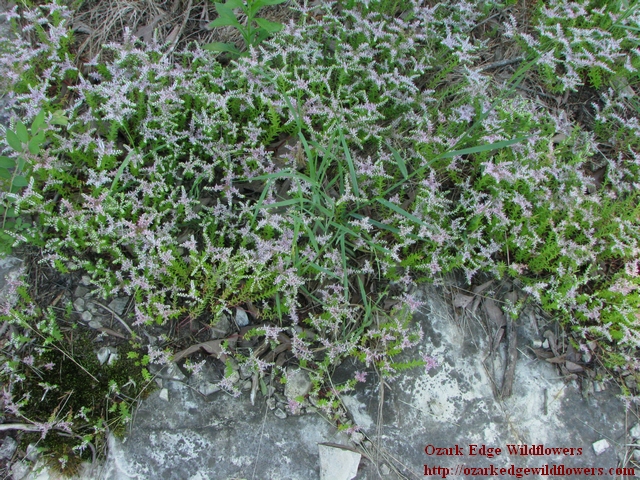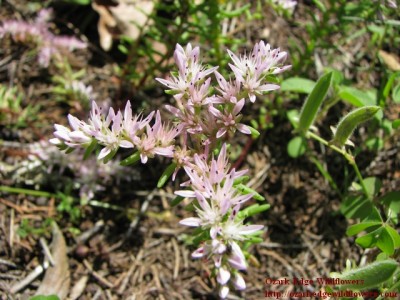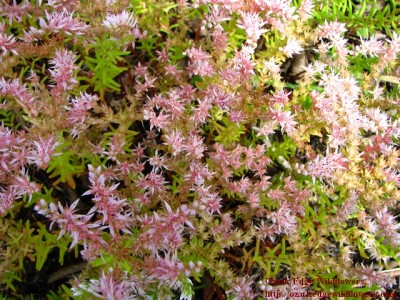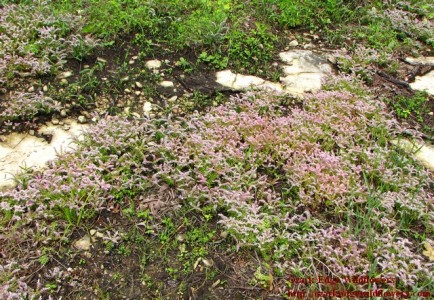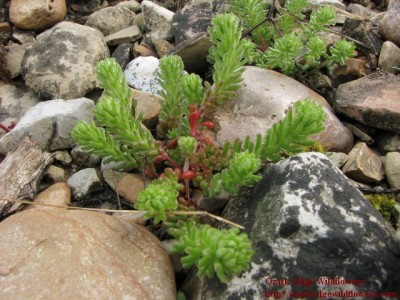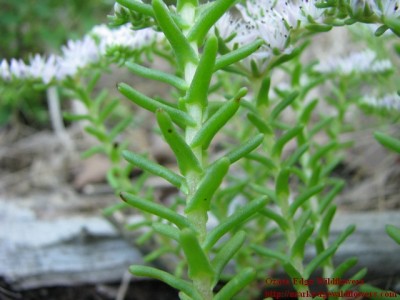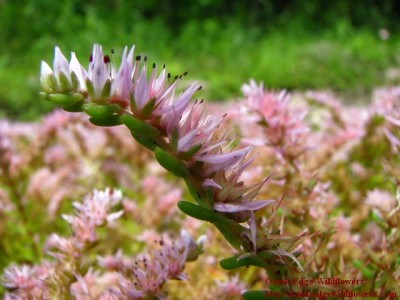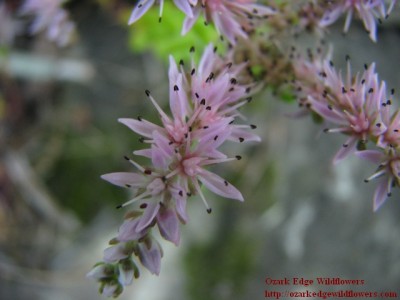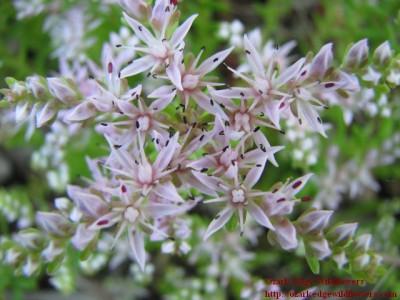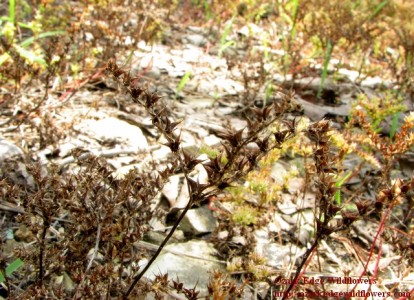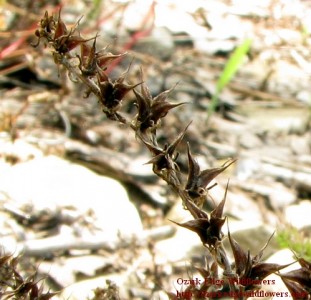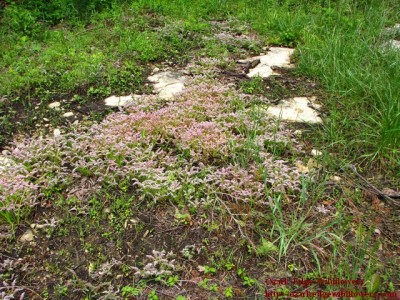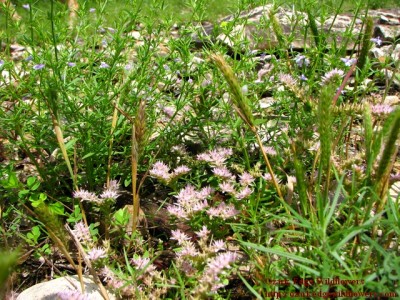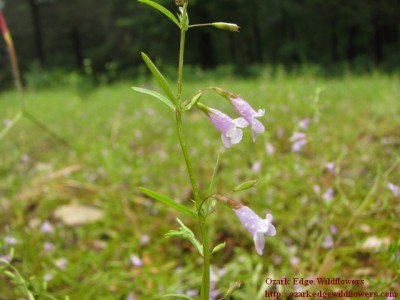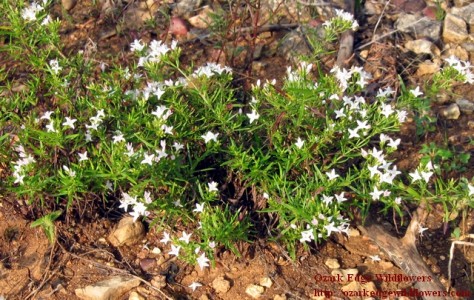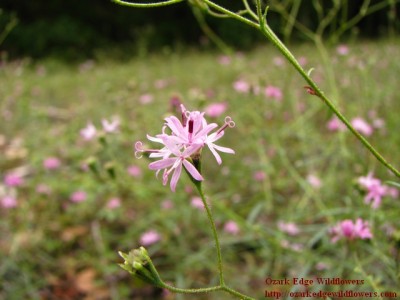Sedum pulchellum is a tough little plant. It lives on the shallow soil typical of cedar glades in the Ozarks. This is rocky ground, and Sedum pulchellum carves out its home in patches of gravel between the large stones. Here it is exposed to the full force of the southern sun. Few plants thrive in such an environment; yet it predictably reappears each spring, then blooms profusely at the beginning of summer. Summer’s drought inevitably arrives, signalling Sedum pulchellum to drop her leaves. The sun dries her seeds and crisps her stem to a toasty brown. It’s all part of the plan. The fall rains work the seeds down into the cracks of the stone and spring brings them out of dormancy–ready to start all over again.
Latin Name/Common Name- Sedum comes from the latin word ‘sedeo’ which means “to sit”, most likely in reference to the recumbent nature of most sedums. The latin meaning of ‘pulchellum’ is pretty or beautiful. This certainly applies here. There are multiple common names for Sedum pulchellum. Two of these are Widow’s Cross and Glade stonecrop. The name Widow’s cross refers to the shape of the flower–there are four petals in a cross pattern. Glade stonecrop is an obvious reference to its typical habitat.
Bloom Color– The colors of Sedum pulchellum are candy heart pink and lime green. Tiny dots of black and red complete the picture. At close range, it is almost too intense—like a teenager’s room. But, I don’t think we are meant to look so closely. The beauty of this plant is better appreciated when you step back and take in the blooms and foliage in combination with the native limestone.
Bright pink and green may seem flamboyant at close range
Step back and the colors of Sedum pulchellum are beautiful against the Ozark limestone
Description- Sedum pulchellum is a low-growing sedum reaching a height of about 8 ” when in bloom. In the literature, I’ve found it to be .described as an annual, biennial and perennial. I think it probably depends on the local climate. On Ozarkedge, it reappears in the same areas each spring, but I haven’t determined if that is from reseeding (annual) or regrowth (biennial or perennial).
The succulent leaves are sessile and appear alternately on the branching stems. The stem is pink to light green. It divides into 3 -5 horizontal branches at its top. The lime green leaves are sometimes shaded red in the early spring. This may be due to the sun, but I suspect it has more to do with the cool spring weather.
Reddish tinge to the young leaves in spring
Fleshy stem may be light green or pink with alternate leaves
The flowers appear on horizontal branches at the top of the plant. This results in a carpet of pink when the plants are in full bloom. Many tiny flowers are packed on each branch. The flowers bloom sequentially from the bottom of the stem to its tip. Each flower has 4 petals (occasionally 5). The red or black tipped stamens spray outward, appearing above and between the petals. This gives the flowers a pretty polka dot charm.
Pink flowers are held above horizontal branches
Each flower has 4 petals
The showy anthers may be black or red
After blooming, the leaves drop, seedpods form and stem turns brown
Four-sided seed pod in late June
Bloom Time- On Ozarkedge, Sedum pulchellum forms its pink carpet of blooms in late April to early May. The pretty flowers persist into June with seedpods developing in June and July.
Habitat- Limestone cedar glades with poor, dry soil and full sun exposure are the preferred habitat for Sedum pulchellum.
Pretty carpet of pink amidst Ozarkedge limestone and glade grasses
What’s Growing Nearby? Even though Sedum pulchellum chooses to live in a seemingly inhospitable location, there are other native flowers growing nearby. Calamintha arkansana blooms at the same time and is found intermingling with this sedum on Ozarkedge. Its light purple blooms are more subtle than Sedum pulchellum, but the fragrance is not! One step on Calamintha arkansana releases the minty perfume that advertises its presence.
Another companion with a similar bloom time is Houstonia longifolia. This small plant has dainty white blooms. In late summer, long after Sedum pulchellum has turned a crispy brown, the wispy, blue green foliage of Palafoxia callosa can be found in the same habitat. It has pink blooms with black anthers that are very similar in color to Sedum pulchellum.
Sedum pulchellum and Calamintha arkansana occupying the same stony ground
Close up view of the soft purple blooms of Calamintha arkansana
Houstonia longifolia is another companion with a similar blooming period
Palafoxia callosa occupies the same habitat but blooms in late summer, early fall
Endangered List- Sedum pulchellum is only known from a minority of Arkansas counties, mostly in the north. Although it is not listed as endangered in any state, it’s range is limited to Alabama, Arkansas, Georgia, Illinois, Kansas, Kentucky, Missouri, Ohio, Oklahoma, Tennessee and Texas.
Distribution of Sedum pulchellum in Arkansas from USDA plant site
http://plants.usda.gov/java/profile?symbol=SEPU
Interesting Tidbits- Sedum pulchellum would make a great addition to a rock garden. The seeds are available online from several reputable dealers.
Beautiful pink star pattern formed by the flowering branches of Sedum pulchellum
